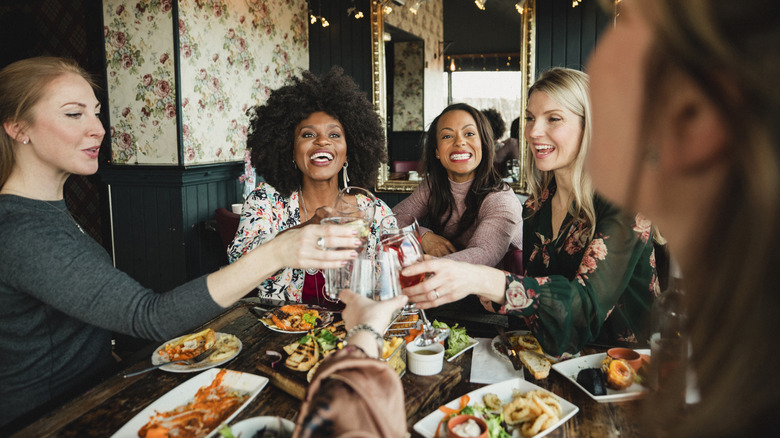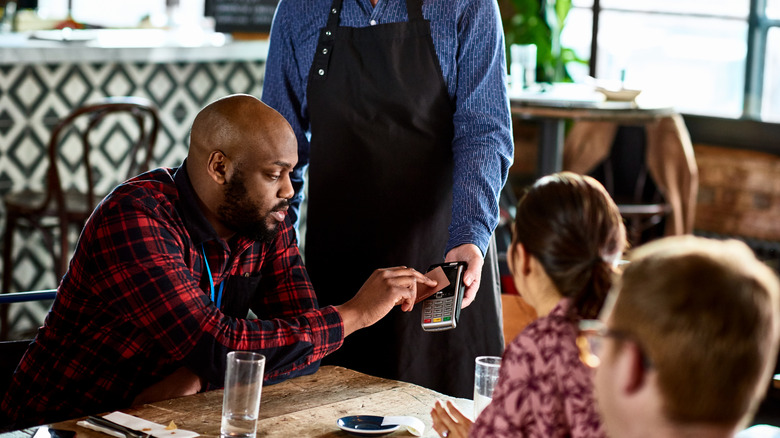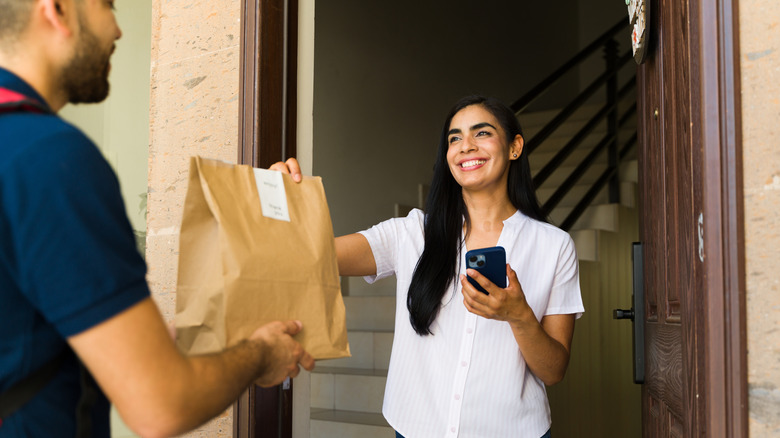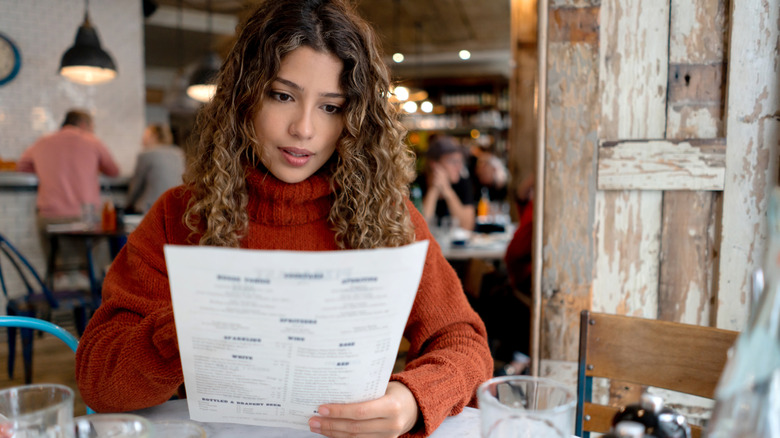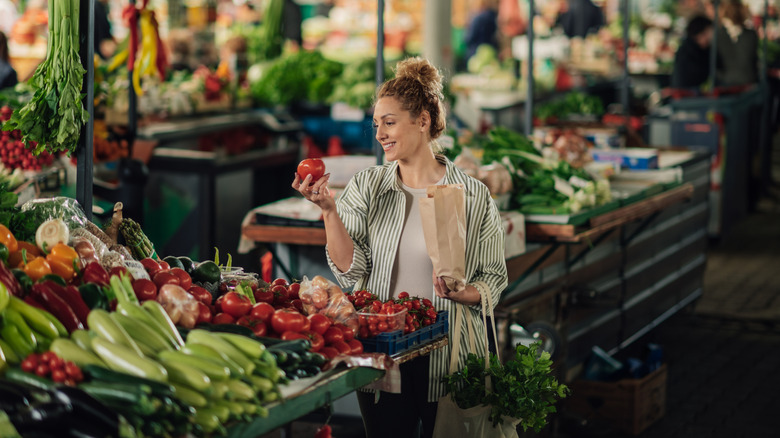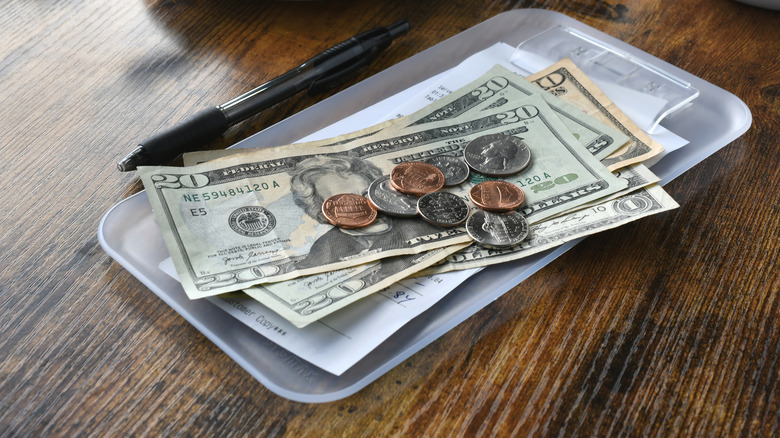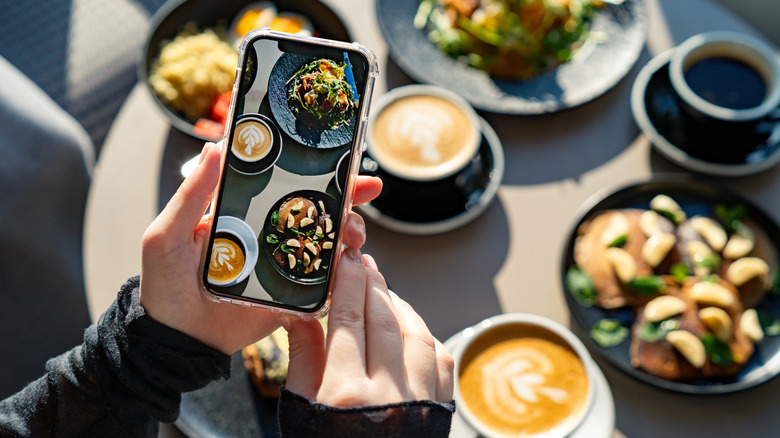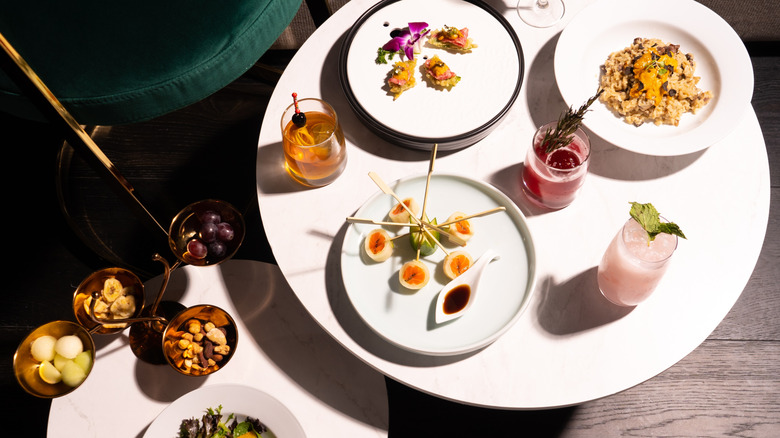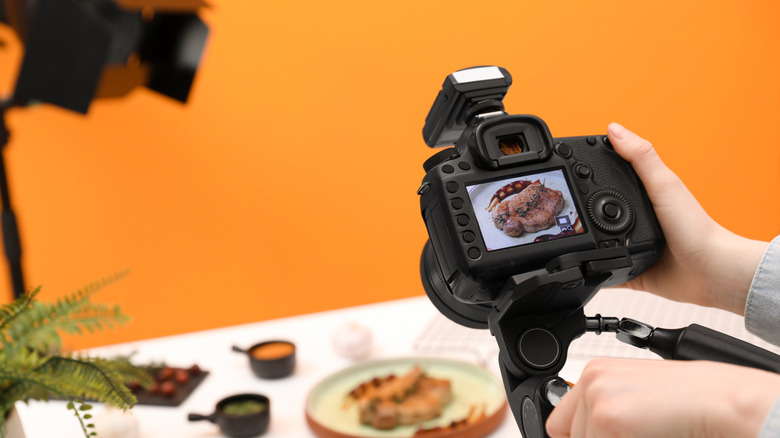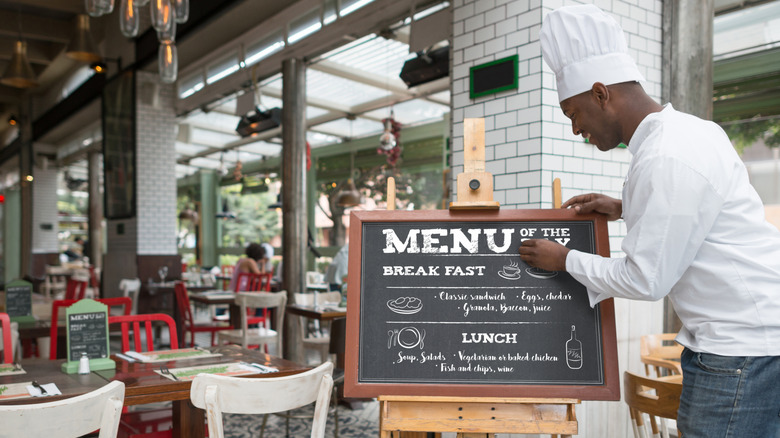Sketchy Restaurant Practices You Should Never Ignore
Restaurants should be places you can relax, enjoy decent food, and trust the people making it. But, unfortunately, that's not always the case — there are some sketchy restaurant practices that can put a damper on a good meal. Whether they're designed to get extra money out of customers or mislead you about the food you're about to eat, they shouldn't be ignored.
As a food writer — and food lover — I've grabbed meals everywhere from hole-in-the-wall spots to restaurants with entries in the Michelin Guide. And while not everywhere is guilty, I've seen the same handful of dodgy practices pop up again and again: surprise charges on the bill, menu descriptions that don't match the plate, and photos online that look nothing like the dish on the table. None of this is rare, but it shouldn't be quietly ignored.
We're not saying that every establishment is up to these tricks. Nor are we saying that a good meal isn't worth good money — plus a sizable tip for the staff. But it's all about transparency. The problem is when what you get doesn't align with what you've been told to expect. If you can spot these traps, you'll make the night out more enjoyable for everyone — including staff who aren't responsible for the tricky policies upstairs. Below are some of the sketchiest restaurant practices you shouldn't ignore.
Surprise service charges
Surprise service charges or convenience fees are getting more and more common in the restaurant industry. It's become such an issue that some states have enacted laws to force establishments to disclose these fees ahead of time. You'll spot the price for your dish on the menu, then get a bill bumped up by a service charge you weren't expecting. It's easy to be forgiving when you've had a lovely meal, but automatic charges are a real issue when they're added without clear explanation or without giving you the option to adjust them.
A good restaurant should disclose these fees ahead of time and tell you what they mean. Part of the problem is that automatic service fees aren't the same everywhere. In some places, a service charge is another name for the tip and in others, it's expected in addition to it. Either way, the ethical line is crossed when a fee is tacked on without being prominent on the menu or explained when you book. Many people assume the service charge will go to staff, but legally, management can pocket it and use it toward the running of the restaurant.
If you see a service charge and you're unsure what it covers, ask. A proper venue will be transparent and able to explain the charge. If you're stuck on a bill with an unexplained fee, a calm conversation usually sorts it — or at least gets you a clear answer on who benefits from it. Assuming the staff doesn't see a penny, it's fine to ask that the optional service charges are removed, and leave a generous tip instead.
Extreme menu markups for delivery
Sometimes you just want to stay home in your PJs and order in from your favorite restaurant. Unfortunately, it's sometimes a shock to your bank account. Many restaurants — or the third-party apps they partner with — add significant markups to menu items for delivery. You might pick a burger that's $15 on the in-house menu and watch it become $20 or more once it lands on the delivery app, sometimes with extra "platform fees" layered on top. For some fast food restaurants, markups can be over 100%, which is enough to make you consider putting your pants on and heading out.
This practice is particularly sneaky because the menu looks the same as the in-restaurant version. By the time you notice the markup, you're already committed. Part of the controversy with DoorDash and other food delivery apps is that they charge the restaurant a fee of 20-30% of the cost of the meal, so restaurants have to make that money back somehow. Often the restaurant's own takeout price is lower, and sometimes they offer a pick-up discount to compensate for third-party commissions.
So, always compare the app price with the restaurant's website before ordering, order direct where possible, and consider collection if you can. If you do use an app, scroll the final checkout page carefully for hidden fees and read the small print about service charges. Some days, you might be willing to pay extra for the convenience, but you should know what you're getting yourself into.
Fake or paid-for reviews
If you've ever picked a place because it boasted a wall of 5-star reviews, only to be underwhelmed when you arrive, you're not alone. Fake and paid-for reviews are everywhere. One of the secrets Yelp doesn't want you to know is that as many as 16% of reviews may be bogus. The Federal Trade Commission has felt the need to set out guidelines over false reviews. So, that restaurant that everyone seems to be raving about online might not be as great as it seems.
Look out for flattering blurbs that sound like ad copy, reviews posted on the same day a restaurant opened, or glowing write-ups that never mention any detail beyond the amazing service. That sort of generic praise is a red flag. Real customers talk about specifics, whereas paid reviews don't. Another tell is repetition. When multiple reviews use the same phrases or odd punctuation, that's a sign someone copy-and-pasted a template. Equally suspicious are places with a sudden flood of perfect ratings after months of middling ones.
A good idea is to check reviews across at least two platforms, look for photos from diners (authentic, imperfect mobile snaps are gold), and read recent posts to see if the buzz is sustained. A quick glance at the reviewer's history helps too — do they review everything indiscriminately or are they a trusted local voice? If something feels off, trust your gut. And when you do find an honestly great place, leave a detailed review. Genuine praise helps diners and businesses.
Lack of transparency or knowledge surrounding allergens
A bad sign in a restaurant is a lack of knowledge or transparency around food allergens. And this one isn't just annoying — it can be dangerous. Food allergies and intolerances range from unpleasant to life-threatening, and a kitchen that treats allergen requests as an afterthought is a place to avoid. While allergen labeling on menus isn't a legal requirement, all staff should be knowledgeable in the area and have access to allergen information for specific dishes.
Good places keep an allergen sheet or can confidently tell you which dishes are safe and what substitutions are possible. They'll also explain cross-contamination risks. It's not okay for a restaurant to simply not know what ingredients go into a dish and whether or not there's a risk of an allergen sneaking its way in. If your waiter seems unsure, ask to speak to someone who knows the kitchen's procedures. If nobody can tell you whether the stock contains gluten, or whether the fryer is shared, that's a sign the establishment hasn't invested in allergen training.
For many folks, allergens aren't something they have to worry about. But, it's a bad sign even if you have no food intolerances. Surely, you want to eat somewhere that can tell you exactly what went into a dish. A vague knowledge of ingredients points toward other sketchy practices.
Misleading menu descriptions
The language on menus can be slippery. You'll probably never know about all the times restaurants lied to you about what's in the food. "Hand-cut fries" might actually be machine-cut; "house-made" can mean the sauce was assembled on-site from a jarred base. These phrases are designed to sound artisanal and sway your expectations.
Food claims made by restaurants are mostly unregulated. Misleading claims about beef are common, with restaurants often claiming labels such as "kobe," "28-day aged," or "USDA prime" without any backing. When you see red snapper on the menu, it usually isn't. Even common fish like cod and halibut are often replaced with cheaper options. And it's unlikely you'll get fresh truffles anywhere but fine dining establishments. Anywhere else, a truffled dish is likely made with fake truffle oil. Once you know some of the most common fake foods to look out for, you can try to avoid them, but it's not foolproof.
When in doubt, ask where the ingredient comes from and how it's prepared. If the response still feels evasive, opt for something straightforward. You're allowed to expect honesty. If a place repeatedly misrepresents what it sells, voting with your feet is a perfectly reasonable response.
False claims of local sourcing
"Locally sourced" sounds lovely — it conjures images of nearby farms, seasonal veggies, and a chef chatting with local producers at a market. The trouble is, the phrase is rarely defined and can be stretched almost indefinitely. There are menus that shout about locally sourced fish or meat where "local" actually meant within the same country. This means you can end up paying a premium price for something that might not be any fresher or more ethical than regular produce.
Restaurants know that local-sourcing sells. It makes establishments look like they put care and thought into their dishes. When that claim isn't backed up, it's just tricky marketing. The giveaway is often vagueness — no named farms or a menu that never changes despite the seasons. Seafood is a notorious offender. Phrases like "line-caught," "wild-sourced," and "local" can mean different things depending on the supplier.
If local sourcing matters to you, ask a single, specific question: "Which farm or supplier does this come from?" A decent venue will proudly name-check their producers and explain what local means to them (sourced within 25 miles, within the county, etc.). If the staff get vague or defensive, consider that a clue. It's fine to charge more for genuinely local and seasonal food, but you're entitled to the context that justifies that price. When a place can't provide this information, it seems sketchy.
Minimum spends
There's a new trend in the U.K. fine dining scene: minimum spends. And while it doesn't seem to have made it to the U.S. in any big way, it's a sketchy practice that might be coming your way soon so it's something to watch out for. A minimum spend is an agreement that everyone in your booking will collectively spend a certain amount. It's common for private dining rooms or big party bookings, but higher-end restaurants of all kinds are starting to bring it in.
The practice isn't necessarily malicious; venues use minimums to manage high-demand slots and offset the cost of no-shows. The problem is when it's not made explicit at booking. You might sit down with a group wanting a drink and a light bite only to be told later you've failed to hit the table's minimum and will be charged the remainder.
Planning a trip to the U.K.? Avoid surprise minimums by asking at the point of booking. Minimums are fine when they're fair and obvious, but not when they're a hidden surcharge. It can also be disappointing when you want to try a particular spot but don't have a big budget. You might have only wanted to drop in for an entree but find that the minimum spend is the price of an entrée, drink, and either an appetizer or dessert.
Not disclosing paid influencer reviews
Whether you love it or hate it, influencer hype is part of modern restaurant marketing. The sketchy bit is that not all influencers disclose when a meal was comped, when they were paid, or when they attended a PR event. Restaurants might also share these posts, not telling followers that the influencer was paid or got a free meal. That turns what looks like genuine recommendation into advertising. You might see videos that omit the fact the entire meal was arranged by the restaurant, or reels that look like a spot was an accidental find when it was actually a curated tasting.
Regulators in many countries require disclosure of paid partnerships, but enforcement is patchy. So, you might need to do some detective work. Check whether the post includes disclaimers like "ad" or "gifted" — as many influencers are honest about this. If not, check whether there has recently been a big opening night or other influencer event. When every foodie in town is suddenly raving on the same day, there's a strong chance the buzz was organized.
If you want to check whether a spot is worth visiting, look for diner photos, unpaid local reviews, and comments from people who are clearly customers. It's not about policing creators, as influencers help small businesses, but it's okay to want to know when praise is earned and when it's been bought. Trust real diners first and treat influencer content as a starting point.
Shrinkflation
Portions becoming smaller — an act known as "shrinkflation" — is the quiet alternative to price hikes. You might not be paying extra but the effect is the same: you get less for your money. We understand why this happens. Ingredient prices, energy costs, and wages go up and restaurants don't want to scare off their customers with rising costs, but it feels dishonest.
Because plating and presentation can disguise size, shrinkflation often goes unnoticed until you've eaten the meal and realize you're still hungry. It comes down to restaurants trying to preserve perceived value — keep the price the same, reduce the food, and hope customers don't notice or complain. It's all very well when the original portion size was so huge that most folks left some and food was going to waste. But, if you're reducing the size of meals that were already only just big enough, it can become a problem.
We get that inflation is real and prices are going up across the board. But establishments shouldn't try to hide this by cutting portion sizes — that's where it gets sketchy. It's totally possible to raise prices fairly and keep customers. And, if places are serious about offering value for money, they could try off-peak deals or smaller, lower-priced dishes to appeal to diners on a budget.
Misleading photos of food
Head to a restaurant's Instagram or Uber Eats page and you might see some drool-worthy snaps. But professional food photography is an art form designed to look perfect on the grid. None of this guarantees the kitchen can reproduce during an average service. Worse is the fact that some places use stock images, which leads to that classic bait-and-switch feeling when your order arrives.
User-submitted photos are far more useful for showing what a dish really looks like. They might be poorly lit or taken at odd angles but they tell you what the kitchen actually produces. Of course, some gorgeous looking dishes on socials doesn't mean that you should be suspicious. But you should probably reign in your expectations. Even if the food is good, it probably won't look as great as it did online.
Ultimately, it's not sketchy to have the best version of a dish professionally photographed for Instagram or promo materials. However, where it gets dodgy is when restaurants use stock photos or take snaps of a version of the dish that's bigger or better than the real thing. That's plain misleading.
Pushing limited time specials regardless of quality
Limited-time offers are designed to activate your scarcity mindset. They get customers to buy because they're only around for a short amount of time and people are afraid of missing out. They can be brilliant — they might be making the most of seasonal ingredients — but they can also be a handy way for kitchens to clear products close to being past their best. For instance, the reason why you should never order a seafood special is that they're usually made with less-than-fresh fish.
Specials are an easy upsell for staff. A well-trained server can make a special sound essential. That doesn't mean every special is dishonest, but it does mean you should consider it carefully. Feel free to ask the servers why the special was chosen. At a good restaurant, they'll be happy to talk about seasonal ingredients or some kind of sourcing that sets it apart from the everyday fare.
There's nothing wrong with restaurants having specials or the servers telling you about it. The sketchy part is when staff heavily push specials that aren't up to scratch. If you go somewhere that serves you up a poor quality special, it might be bad luck or it might be a sign that the establishment uses its specials to get rid of odds and ends or produce that's close to going bad.
